![]()
![]()
![]()
Use LEFT and RIGHT arrow keys to navigate between flashcards;
Use UP and DOWN arrow keys to flip the card;
H to show hint;
A reads text to speech;
103 Cards in this Set
- Front
- Back
|
Weathering
|
The disintegration and decomposition of rock at or near the surface of the earth
|
|
|
Mass Wasting
|
the down-slope movement of rock, regolith, and soil under the direct influence of gravity
|
|
|
Erosion
|
the incorporation and transportation of material by a mobile agent, such as water, wind, or ice.
|
|
|
Mechanical Weathering
|
The Physical disintegration of rock, resulting in smaller fragments
|
|
|
Chemical Weathering
|
the process by which the internal structure of a mineral is altered by the removal and/or addition of elements
|
|
|
Mechanical Weathering: Unloading
|
Igneous Rocks -mainly Granite- that crack into layers when pressure is removed. This creates exfoliation domes.
Ex. stone mountain in Georgia and half done and liberty cap in Yosemite national park. |
|
|
Mechanical Weathering: Frost Wedging
|
When water works its way into cracks in rock, upon freezing, expands and enlarges these openings.
After multiple freezing and thawing cycles, the rock breaks into angular fragments. This happens the most often in the mountains. When it happens enough, it creates talus slopes |
|
|
Mechanical Weathering: Biological Activity
|
Rocks are weathered by plants roots growing through the rocks, animals borrowing through the rocks, acid from decaying organisms also wears away on the rocks.
The most devastating is people blowing up, paving, or removing rocks. |
|
|
Mechanical Weathering: Thermal expansion
|
The heating and cooling of rocks causes deformation and destruction.
This is seen greatest when temperatures exceed 30 degrees Celsius. Rock will be more proned to this weathering if chemical weathering has occurred first. |
|
|
Chemical Weathering: Dissolution
|
The Process of dissolving into a homogeneous solution, as when an acidic solution dissolves limestone
Halite dissolves into water |
|
|
Chemical Weathering: Hydration
|
Hydration is the chemical addition of water molecules to a mineral. This process frequently produce a new mineral compound. In addition, the size of the mineral structure is increased causing stress and developing zones of weakness. This can increase the overall permeability of the stone and lead to spalling, pitting and flaking. Overall color changes can take place as well
|
|
|
Chemical Weathering: Hydrolysis
|
Chemically changing a mineral when it reacts to acids and waters
The silicates react the most to this process because of the hydrogen atom. Carbonic Acid also has a major effect. Kaolinite is the most populous item created by hydrolysis |
|
|
Chemical Weathering: Oxidation
|
The removal of one or more electrons from an atom or ion. so named because elements commonly combine with oxygen.
iron Rich rocks are likely to have have this problem such as olivine, pyroxene, and hornblende. this can create hematite or limonite. With silicates, this can only happen when hydrolysis removes the iron from the silicates. Sulfides can also oxidize, such as pyrite |
|
|
Weathering Stability Series
|

|
|
|
How climate affects the dominant type of weathering
|
Chemical: In a Hot, Wet climate chemical weathering is increased because the weathering occurs rapidly and completely, thereby making mechanical weathering less important
Mechanical: a dry climate because chemical weathering will occur slowly, thereby making chemical weathering more important |
|
|
Role of Climate in weathering Feldspar
|
Feldspar (dry Climate) becomes Kaolinite (mod temperate )
or becomes Bauxite in extreme temperate |
|
|
Role of climate in weathering Granite
|
Temperate
Quartz becomes quartz grain Feldspar becomes clay Arid Quartz becomes quartz grain Feldspar becomes feldspar grains |
|
|
Role of Joints in Weathering
|
The surface area will increase but the volume will not increase.
Increasing the surface area will increase the exposure to fluids; therefore, chemical weathering will be increased The corners will dissolve faster than the sides Powdered sugar dissolves quicker than cubed sugar |
|
|
Differential erosion in humid and arid climates
|
Humid
Sandstones (survive)----> ridges and cliffs Shale(weak) -------------> valleys and slopes Limestone(weak) -----> Valleys and slopes Arid Sandstone (Strong) -------Ridges and cliffs Shales (weak) ------> valleys and slopes Limestone (strong) --------> ridges and cliffs |
|
|
Weathering Products
|
Solid particles (mechanical and Chemical weathering
Dissolved Ions (chemical Weathering) These products are transported by rivers, waves, wind, glaciers, gravity (e.g. landslides) |
|
|
Lithification
|
The process by which sediment becomes sedimentary rock
Compaction and cementations |
|
|
Clastic
|
transported and deposited as solid
|
|
|
Chemical
|
precipitated inorganically from solutions
|
|
|
Biochemical
|
precipitated organically from solution
|
|
|
How are Clastic and sediment and sedimentary rocks classified?
|
Clastic
Discrete fragments and particles all detritl rocks have a Clastic texture Nonclastic (chemical Pattern of interlocking crystals may resemble an igneous rock Texture Composition |
|
|
Clastic Textures
|
Grain size
Grain shape Grain Sorting |
|
|
significance of grain size
|
>2 mm
This is gravel. it tells me that this is a detriral rock, and it tells me either conglomerate (smooth size) or Breeca (angular) 1/16th<>2mm Sand (creates sandstone) <1/16 Silt or mud (creates mudstone) |
|
|
signifcance of grain shape
|
Tells me how the sand was created
|
|
|
significance of grain sorting
|
Poorly sorted sediment has been rapidly deposited, with little reworking (maybe by landslip or glaciers
Low porosity Well Sorted Sediment has been extensively reworked high porosity |
|
|
Conglomerate
|
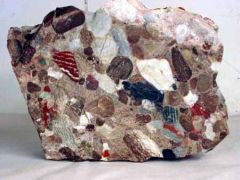
|
|
|
Breccia
|
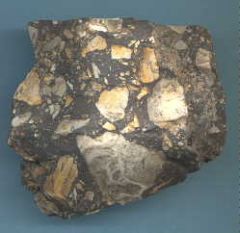
|
|
|
Sandstone
|
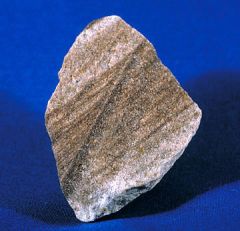
|
|
|
Shale
|
|
|
|
Shale
|
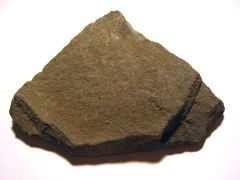
|
|
|
Quartz Arenite
|
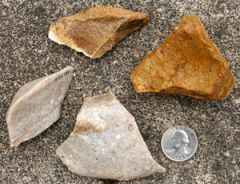
|
|
|
Arkose
|
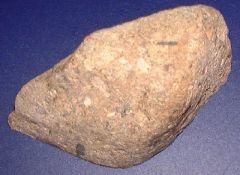
|
|
|
|
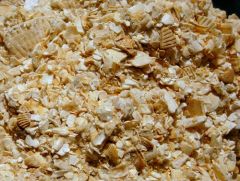
|
|
|
Limestone
|
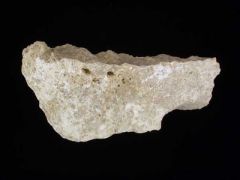
|
|
|
Chalk
|
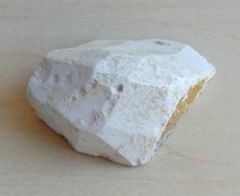
|
|
|
Chert
|

|
|
|
indicators of clastic depositinal environment
|
GRain size
Grain sorting Grain Shape Bedforms (ripples) Sedimentary Structures Fossils |
|
|
Sequence of precipitation from the evaporation of sea water
|
1st: Calcite (CaCO3 )( 1/3%)
2nd: Gypsum (CaSO4 * 2H2)) (3 1/2%) 3rd: Halite (NaCl) (78%) 4th: Bitterns (KCl & MgCl) (11%) 5th: Nitrates (NaNO3) trace |
|
|
Types of Biochemical
|
Limestone
Chert Coal |
|
|
Types of inorganic
|
TRavertine
Most Chrts vaporites |
|
|
Bulleye
|
Outer ring is calcite
inner ring is Gypsum next layer is Halite fourth layer is Bitterns the bulleye is Nitrates This is used to find our key minerals |
|
|
Potassium
|
a lot is found where evaporation
It came from k-feldspar by chemical weathering |
|
|
Nitrates
|
atacoma deserts
|
|
|
Posphate
|
it comes from apatite and organic material
|
|
|
how coal forms
|
Conditions for coal
1. High rate of biological productivity 2. Preserved in a reducing environment 3. burial/ compation Stage one- Peat is buried and becomes compacted Stage two- Lignite or Brown Coal (15-30% Carbon/ low Grade) Stage 3 black coal (50- 80% carbon) Stage 4 (metamorphism) Carbon (85-95%) |
|
|
How oil Forms
|
Conditions
1. High rate of Biological productivity (mainly marine micro-organisms) 2. Presusuve in a reducing environment 3. Burial/ compaction/ maturation (squeezed out the organic fluid) 4. migration through a permeable rock 5. trapped by an impermeable seal |
|
|
Metamorphism
|
the solid-state change in composition, mineralogy, or texture, of pre-existing rocks due to the change in temperature, pressure, or chemical components.
|
|
|
Agents of metamorphism
|
Stress (confining pressure<equal Pressure> and differential stress<unequal pressure>)
Heat Chemically Active Fluids |
|
|
How Does pressure and temperature vary with Depth
|
Pressure increases with depth. Temperature increases with depth.
|
|
|
Geothermal Gradient
|
the rate at which temperature increases with depth
1. Burial will increase pressure 2. Subduction 3. heating from Intrusion 4. Hot Fluids 5. Change in Stresses 6. Shearing |
|
|
Regional
|
Changes caused by the high temperature and directed pressures associated with regional mountain building
These rocks with be highly deformed and recrystallized rocked |
|
|
Contact
|
Changes caused by the high temperature of an intruding magma, which can "bake" the surrounding rock.
(Marble) |
|
|
Hydrothermal
|
Changes caused by interaction of hot, chemically rich fluids with surrounding rock
|
|
|
Metamorphic classifcation
|
Texture: foliated (Regional) and Non-Foliated (Contact)
composition (what minerals are present) |
|
|
Types of Metamorpic Foliation
|
Schistosity: elongate and platy minerals recrystallize along parallel planes
Gneissic Texture: dark and light colored minerals segregate into compositional Bands Deformation: flattening of grain due to directed stresses |
|
|
Slatey Cleavage
|
Planes at right angles against the fold lines
You can make shingles out of slate |
|
|
What is metamorphic Foliated
|
Physical
Rotation (mineral particles turn) and Deformation (pressure is applied that flattens the minerals) Chemical Recrystallization ( the crystals will grow to the area of less pressure) Re-mobilization ( the location of minerals will change) |
|
|
Slate is metamorphosed
|
Slate (low grade)---> phyllite(Medium Grade) ---> Schist(High GRade)--- (Gneiss)
|
|
|
Gneissic Texture
|
The stresses are so high that the minerals are completely rearranged into a banded appearance
|
|
|
Contact Aureole
|
The area adjacent to an intrusive that has been altered by contact metamorphism (i.e. the "baked rim") is called the metamorphic aureole.
|
|
|
Bedding Vs. Foliation
|
Bedding separates the sedimentery rocks
Foliation is the layering of a metamorphic rock |
|
|
Non-Foliated Meta Rocks
|
Quartzite (Contact), Marble (Contact), Hornfels (Contact), Anthracite
|
|
|
How do you tell the difference between Metamorphic and non-metamorphic Rocks?
|
Texture
Metamorphic will be combined and of relatively the same size and form Composition can also help because it will combine multiple minerals Calcite happens because of a recrystalization |
|
|
Metamorphic Facies
|
An assemblage of rocks with Characteristic minerals formed under specific temperature and pressure conditions
|
|
|
Metamorphic Facies Chart
|
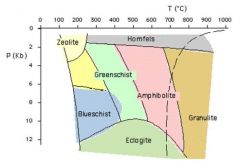
|
|
|
Migmatites
|
a rock that is both igneous and metamorphic rock characteristics. such rocks may form when light colored silicate minerals melt and the crystallize, while the dark silicate minerals remain solid
Such ask nice mixed with Granite |
|
|
Protoliths
|
Sandstone becomes quartzite (contact)
Limestone becomes Marble (contact) Shale becomes slate, phyllite, schist, Gneiss These happens because of increasing pressures and tempetures Basalt become Greenstone, Green Schist, Amphibolite (not much banding because of the lack of felsic minerals) GRanite becomes schist and gneiss |
|
|
Hornfels
|
this will form near high temp and lower pressure
|
|
|
Blue Schist
|
Low pressure lower temps
|
|
|
Greenschist or amphobolite
|
High temp and high pressure
|
|
|
Stress and types
|
an applied for or force per unite area
Types of stress Compression (->db<-), tension (<-d b->), or sheer (Down dP ^) |
|
|
Strain and types
|
Change in the shape or size due to an applied force (stress)
This is Deformation Elastic - a temporary change in shape or size that is recovered when the applied stress is removed Ductile (plastic)a permanent change in shape or size by bending or flowage that is not recovered when the stress is removed Brittle (rupture)- the loss of cohesion due to an applied force. (it breaks) |
|
|
Strength and typs
|
The ability of an object to resist deformation
Types compressive (i cant be pushed in) or tensile (i cant be pulled apart) strength |
|
|
Fault
|
a fracture along which movement has occurred
|
|
|
effects if pressure
|
High pressure= ductile deformation
Low pressure = brittle deformation |
|
|
Effects of temperature
|
High Temp= ductile deformation
low temp= brittle deformation |
|
|
Strain Rate
|
quickly= brittle deformation
slowly= ductile |
|
|
effects of composition
|
hard= brittle
soft= ductile |
|
|
Strike
|
the compass direction of the line of intersection created by a dipping bed or fault and a horizontal surface. strike is always perpemdicular to the direction of dip
|
|
|
Dip
|
the angle at which a rock layer or fault is inclined from the horizontal. the direction of dip is at a right angle to the strike
|
|
|
dip and strike symbol
|
˧
|
|
|
vertical strike
|
ᐩ
|
|
|
Horizontal
|
it is a gun site
|
|
|
Axial plane
|
the imaginary plane that divides a fold
|
|
|
Superposition
|
the ideas that the top layer is younger than the layer that is below it.
This helps to date rocks. |
|
|
Principle of original horizontality
|
layers of sediment are generally placed in horizontal layers
undisturbed layers are in their original form |
|
|
principle of cross cutting relationships
|
any feature that cuts across a rock or body of sediment must be younger that the rock or sediment that it cuts across
|
|
|
Dis-conformity
|
an nonconformity between parallel strata or lava flows
|
|
|
angular Unconformity
|
an unconformity between two sets of strata that are not parallel to one another
|
|
|
nonconformity
|
an unconformity between younger sedimentary rocks and subjacent metamorphic or igneous rocks. It forms when stratified sedimentary rocks or lava flows are distributed on eroded igneous or metamorphic rocks
|
|
|
Inclusions
|
fragments of one rock that have been enclosed within another.
|
|
|
Precambrianera
|
the 4 billion years before the Cambrian Age
4550-543 |
|
|
Phanerozoic Eon
|
542-present
This is the time where life is on the plant |
|
|
paleozoic era
|
543-248
|
|
|
mesozoic era
|
248-65
|
|
|
cenozoic Era
|
65- today
|
|
|
alpha emission decay
|
s a type of radioactive decay in which an atomic nucleus emits an alpha particle, and thereby transforms (or 'decays') into an atom with a mass number 4 less and atomic number 2 less.
2 protons and two neutrons= alpha |
|
|
beta emission decay
|
is a type of radioactive decay in which a beta particle (an electron or a positron) is emitted.
|
|
|
electron capture
|
is a decay mode for isotopes that will occur when there are too many protons in the nucleus of an atom and insufficient energy to emit a positron; however, it continues to be a viable decay mode for radioactive isotopes that can decay by positron emission
|

